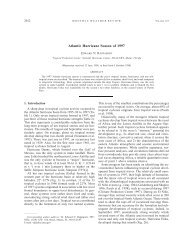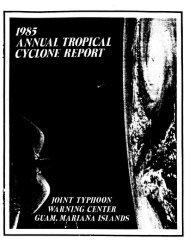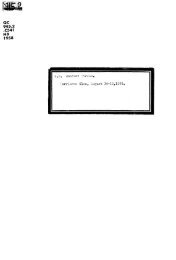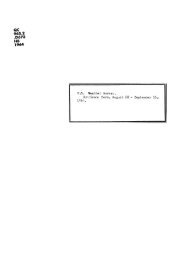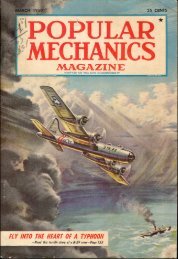Hurricane Gilbert Sept 3-16 1988 - NOAA
Hurricane Gilbert Sept 3-16 1988 - NOAA
Hurricane Gilbert Sept 3-16 1988 - NOAA
Create successful ePaper yourself
Turn your PDF publications into a flip-book with our unique Google optimized e-Paper software.
y the local NWS office. Also, local<br />
newscasters aside from the weathercaster<br />
should be encouraged to attend preparedness<br />
activities and educate themselves<br />
about public safety threats associated with<br />
hurricanes.<br />
*** Finding 3.1 (Lack of tide information)<br />
EMCs had a problem in determining tide<br />
levels. Tide levels are vital for the decision<br />
to evacuate the islands, as most causeways<br />
are near sea level. Tide level data are sorely<br />
lacking all along the Gulf Coast; most<br />
locations don't have gauges, and many that<br />
are present are not reliable.<br />
*** Recommendation 3.1<br />
Dr. Michael Speed of Corpus Christi State<br />
University would like to establish a tide<br />
gauge network in Corpus Christi Bay, but<br />
lacks funding. The Southern Region Headquarters<br />
of NWS and <strong>NOAA</strong> should coordinate<br />
with Dr.Speed in his effort and<br />
investigate the possibility of cost-sharing.<br />
Southern Region Headquarters should also<br />
act on the request for an additional HAND-<br />
AR unit for Port Mansfield.<br />
In addition, the NWS should initiate a<br />
NOM-wide effort to ensure that an operational<br />
network of tide gauges is installed<br />
along the Gulf coast. Not only must the<br />
tide gauges be installed but effective means<br />
for using the data for forecasts must also be<br />
instituted.<br />
*** Finding32 (Direct communications link<br />
between NWS Offices and Emergency<br />
Operating Centers (EOCs))<br />
The desire by EMCs to speak directly to<br />
NWS personnel was found to be<br />
widespread, despite the fact that all per-<br />
tinent information is contained in statements<br />
issued by the NHC and local NWS offices.<br />
Due to the large number of EOCs<br />
affected along the Texas coast, direct communication<br />
between the NWS and the<br />
EOCs was at times impeded, especially<br />
telephone communication. Several EMCs<br />
felt they were getting too much information<br />
in the form of printed statements and had<br />
to call the N WS just to get a picture of what<br />
was happening. The Turns provided a<br />
continuous stream of information, which<br />
was too hard to filter for pertinent material.<br />
+** Recommendation 3.2<br />
As part of the its modernization plans, the<br />
NWS recognizes the need for a direct communications<br />
link between its offices and<br />
local government officials. Finding 32 supports<br />
the need for a direct link<br />
Prior to the modernization, the NWS and<br />
local communities should pursue other<br />
means of direct communication. For example,<br />
Mike Pass, MIC of WSO Houston,<br />
recommended establishing a "hot-line" between<br />
the local office and the EOCs. Such<br />
a hot-line was established, for example, between<br />
the EOC in Corpus Christi and the<br />
local WSO. In the future, additional<br />
telephone lines should be considered by<br />
each MIC during a hurricane event.<br />
*** Finding 33 (External coordination)<br />
Personnel at Kelly AFB, San Antonio, issued<br />
a tornado warning after a tornado had<br />
been spotted at 6:35 am CDT by base personnel.<br />
The tornado report was not communicated<br />
to WSFO San Antonio.<br />
*** Recommendation 33<br />
WSFO San Antonio and Kelly AFB need to<br />
review and update their reciprocal communications<br />
agreement whereby both are<br />
27



